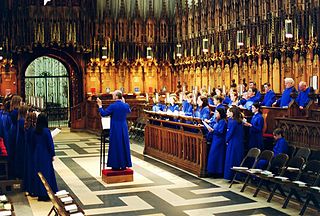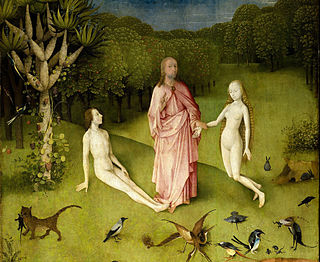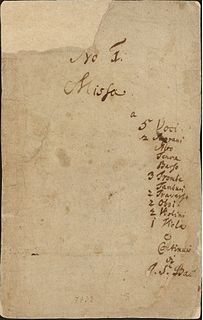
A choir is a musical ensemble of singers. Choral music, in turn, is the music written specifically for such an ensemble to perform. Choirs may perform music from the classical music repertoire, which spans from the medieval era to the present, or popular music repertoire. Most choirs are led by a conductor, who leads the performances with arm and face gestures.
The musical term alto, meaning "high" in Italian, historically refers to the contrapuntal part higher than the tenor and its associated vocal range. In 4-part voice leading alto is the second highest part, sung in choruses by either low women's or high men's voices. In vocal classification these are usually called contralto and male alto or countertenor.
The alto clarinet is a woodwind instrument of the clarinet family. It is a transposing instrument pitched in the key of E♭, though instruments in F have been made. In Europe it is sometimes called a tenor clarinet. In size it lies between the soprano clarinet and the bass clarinet. It bears a greater resemblance to the bass clarinet in that it typically has a straight body, but a curved neck and bell made of metal. All-metal alto clarinets also exist. In appearance it strongly resembles the basset horn, but usually differs in three respects: it is pitched a tone lower, it lacks an extended lower range, and it has a wider bore than many basset horns.
Franz Xaver Biebl was a German composer of classical music. Most of his compositions were for choral ensembles.

A Ceremony of Carols,Op. 28, is a choral piece by Benjamin Britten, scored for three-part treble chorus, solo voices, and harp. Written for Christmas, it consists of eleven movements, with text from The English Galaxy of Shorter Poems, edited by Gerald Bullett. The text is principally in Middle English, with some Latin and Early Modern English. The piece was written in 1942 while Britten was at sea, travelling from the United States to England.
Hendrik Pienaar Hofmeyr is a South African composer. Born in Cape Town, he furthered his studies in Italy during 10 years of self-imposed exile as a conscientious objector. While there, he won the South African Opera Competition with The Fall of the House of Usher. He also received the annual Nederburg Prize for Opera for this work subsequent to its performance at the State Theatre in Pretoria in 1988. In the same year, he obtained first prize in an international competition in Italy with music for a short film by Wim Wenders. He returned to South Africa in 1992, and in 1997 won two major international composition competitions, the Queen Elisabeth Music Competition of Belgium and the first edition of the Dimitris Mitropoulos Competition in Athens. His 'Incantesimo' for solo flute was selected to represent South Africa at the ISCM World Music Days in Croatia in 2005. In 2008 he was honoured with a Kanna award by the Kleinkaroo National Arts Festival. He is currently Professor and Head of Composition and Theory at the South African College of Music at the University of Cape Town, where he obtained a DMus in 1999.

Kerry Andrew is an English composer, performer and author.

The De La Salle Zobel Chorale is a musical group from De La Salle-Santiago Zobel School in Muntinlupa City, Philippines. The DLSZ Chorale consists of two sub-groups, Grade School Choir and High School Choir. The Chorale's elite group, "Young Singers" or "YS", are members that are specially selected from SSA section from the High School Chorale.
The Silver Swan is probably the most famous madrigal by Orlando Gibbons. It is scored for 5 voices and presents the legend that swans sing only just before their deaths.
Jonathan Willcocks is an English composer and conductor.

Donald Henry Kay AM is an Australian classical composer.
There is no authoritative system of voice classification in non-classical music as classical terms are used to describe not merely various vocal ranges, but specific vocal timbres unique to each range. These timbres are produced by classical training techniques with which most popular singers are not intimately familiar, and which even those that are do not universally employ.

The Creation, the oratorio by Joseph Haydn, is structured in three parts. He composed it in 1796–1798 on German text as Die Schöpfung. The work is set for soloists, chorus and orchestra. Its movements are listed in tables for their form, voice, key, tempo marking, time signature and source.

The Mass in B minor is Johann Sebastian Bach's only setting of the complete Latin text of the Ordinarium missae. Towards the end of his life, mainly in 1748 and 1749, he finished composing new sections and compiling it into a complex, unified structure.
Steven Sametz is active as both conductor and composer. He has been hailed as "one of the most respected choral composers in America." Since 1979, he has been on the faculty of Lehigh University in Bethlehem, Pennsylvania, where he holds the Ronald J. Ulrich Chair in Music and is Director of Choral Activities and is founding director of the Lehigh University Choral Union. Since 1998, he has served as Artistic Director of the professional a cappella ensemble, The Princeton Singers. He is also the founding director of the Lehigh University Summer Choral Composers’ Forum. In 2012, he was named Chair of the American Choral Directors Association Composition Advisory Committee.
"I will sing with the spirit" is a sacred choral composition by John Rutter. The biblical text is taken from 1 Corinthians 14:15, adding to the second half of the verse an often repeated "alleluia". Rutter scored the piece for four vocal parts (SATB) and organ, adding other versions. He composed it in 1994 for the Royal School of Church Music in England.

Victor (Vic) Nees was a Belgian (Flemish) composer, choral conductor, musicologist, and music educator.

Derek Edward Healey is an English composer, organist, and music educator whose more than 50 published works include orchestral and chamber pieces, an opera, and several organ and choral works.
Ave Maria is a motet by Franz Biebl, composed before 1959 for double choir, a large four-part choir and a three-part choir. It is a setting of part of the Latin liturgical Angelus prayer, which contains the Ave Maria as a refrain. The composition was originally written for men's chorus but became internationally famous in an arrangement for mixed choir.








